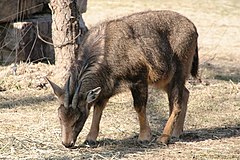Goral
| Naemorhedus[1] | |||
| C.H. Smith, 1827[2] | |||
 Przedstawiciel rodzaju – goral długoogonowy (Nemorhaedus caudatus) | |||
| Systematyka | |||
| Domena | |||
|---|---|---|---|
| Królestwo | |||
| Gromada | |||
| Podgromada | |||
| Infragromada | |||
| Rząd | |||
| Podrząd | |||
| Infrarząd | |||
| Rodzina | |||
| Podrodzina | |||
| Plemię | |||
| Rodzaj | goral | ||
| Typ nomenklatoryczny | |||
Antilope goral Hardwicke, 1825 | |||
| Synonimy | |||
| Gatunki | |||
| |||
Goral[12] (Naemorhedus) – rodzaj ssaka z podrodziny antylop (Antilopinae) w obrębie rodziny wołowatych (Bovidae).
Zasięg występowania
Rodzaj obejmuje gatunki występujące w Azji[13][14][15].
Morfologia
Długość ciała 50–132 cm, długość ogona 7–20,3 cm, długość ucha 9,5–15 cm, wysokość w kłębie 50–75 cm; długość rogów 7,5–23,5 cm; masa ciała 20–47 kg[14].
Systematyka
Etymologia
- Naemorhedus (Naemorhaedus, Nemorhaedus, Nemorhedus, Nemorrhedus, Nemorhoedus, Nemorrhaedus): łac. nemus, nemoris „las, gaj”; haedus „koziołek”[16].
- Kemas: gr. κεμας kemas „młody jeleń”[17]. Gatunek typowy: Antilope goral Hardwicke, 1825.
- Caprina: łac. caprinus „jak koza, kozi”[18]. Gatunek typowy: nie podany, wymieniono kilka gatunków; młodszy homonim Caprina d’Orbigny, 1822 (Mollusca).
- Urotragus: gr. ουρα oura „ogon”; τραγος tragos „kozioł”[19]. Gatunek typowy: Antilope caudata Milne-Edwards, 1867.
Podział systematyczny
Badania cytochromu b wykazały bliskie pokrewieństwo Capricornis, Naemorhedus i Ovibos[15]. Do rodzaju należą następujące występujące współcześnie gatunki[13][12]:
- Naemorhedus goral (Hardwicke, 1825) – goral himalajski
- Naemorhedus bedfordi (Lydekker, 1905)
- Naemorhedus griseus Milne-Edwards, 1871 – goral szary
- Naemorhedus evansi (Lydekker, 1905)
- Naemorhedus caudatus (Milne-Edwards, 1867) – goral długoogonowy
- Naemorhedus baileyi (Pocock, 1914) – goral brunatny
Opisano również wymarły plejstoceński gatunek z Japonii[20]:
- Naemorhedus nikitini Shikama, 1949[20]
Uwagi
- ↑ a b c d e Niepoprawna późniejsza pisownia Naemorhedus C.H. Smith, 1827.
- ↑ Niepoprawna późniejsza pisownia Naemorhedus C.H. Smith, 1827; Groves i Grubb sugerują, że poprawnie zlatynizowaną nazwą jest Nemorhaedus, jednak nie wszyscy autorzy są zgodni z takim stanowiskiem (np. Nowak, 1999; baza ITIS, IUCN).
Przypisy
- ↑ Naemorhedus, [w:] Integrated Taxonomic Information System [online] (ang.).
- ↑ C.H. Smith: Synopsis of the species of the class Mammalia. W: G. Cuvier & E. Griffith (red.): The animal kingdom: arranged in conformity with its organization. Cz. 5. London: G.B. Whittaker, 1827, s. 352. (ang.).
- ↑ W. Jardine: The naturalist’s library. Cz. 22: Mammalia. Ruminantia:–Part. II. Edynburg: W. H. Lizars, 1836, s. 97. (ang.).
- ↑ W. Ogilby. On the generic characters of Ruminants. „Proceedings of the Zoological Society of London”. 4, s. 138, 1836. (ang.).
- ↑ B.H. Hodgson. Classified Catalogue of Mammals of Nepal, (corrected to end of 1841, first printed in 1832.). „The Journal of the Asiatic Society of Bengal”. 10 (2), s. 913, 1841. (ang.).
- ↑ Mammalia. W: L. Agassiz: Nomenclator zoologicus, continens nomina systematica generum animalium tam viventium quam fossilium, secundum ordinem alphabeticum disposita, adjectis auctoribus, libris, in quibus reperiuntur, anno editionis, etymologia et familiis, ad quas pertinent, in singulis classibus. Soloduri: Jent et Gassmann, 1842–1846, s. 22. (łac.).
- ↑ J.E. Gray: List of the specimens of Mammalia in the collection of the British museum. London: The Trustees, 1843, s. 166. (ang.).
- ↑ J.A. Wagner: Supplementband. W: J.Ch.D. von Schreber: Die Säugthiere in Abbildungen nach der Natur, mit Beschreibungen. Cz. 4: Die Nager (zweiter Abschnitt), Bahnlücker, Einhufer, Dickhäuter und Wiederkäuer. Erlangen: Expedition des Schreber’schen säugthier- und des Esper’schen Schmetterlingswerkes, 1844, s. xi, 457. (niem.).
- ↑ B.H. Hodgson. On Various Genera of the Ruminants. „The Journal of the Asiatic Society of Bengal”. 16 (2), s. 697, 1847. (ang.).
- ↑ J.E. Gray. The Chinese long-tailed goat antelope (Urotrague caudatus). „The Annals and Magazine of Natural History”. Fourth series. 8, s. 371, 1871. (ang.).
- ↑ É.L. Trouessart: Catalogus mammalium tam viventium quam fossilium. Wyd. Nova ed. (prima completa). Cz. 2. Berolini: R. Friedländer & sohn, 1898, s. 964. (łac.).
- ↑ a b Nazwy zwyczajowe za: W. Cichocki, A. Ważna, J. Cichocki, E. Rajska-Jurgiel, A. Jasiński & W. Bogdanowicz: Polskie nazewnictwo ssaków świata. Warszawa: Muzeum i Instytut Zoologii PAN, 2015, s. 182. ISBN 978-83-88147-15-9. (pol. • ang.).
- ↑ a b C.J. Burgin, D.E. Wilson, R.A. Mittermeier, A.B. Rylands, T.E. Lacher & W. Sechrest: Illustrated Checklist of the Mammals of the World. Cz. 2: Eulipotyphla to Carnivora. Barcelona: Lynx Edicions, 2020, s. 368. ISBN 978-84-16728-35-0. (ang.).
- ↑ a b C. Groves, D. Leslie, B. Huffman, R. Valdez, K. Habibi, P. Weinberg, J. Burton, P. Jarman & W. Robichaud: Family Bovidae (Hollow-horned Ruminants). W: D.E. Wilson & R.A. Mittermeier (red. red.): Handbook of the Mammals of the World. Cz. 2: Hoofed Mammals. Barcelona: Lynx Edicions, 2011, s. 743–745. ISBN 978-84-96553-77-4. (ang.).
- ↑ a b D.E. Wilson & D.M. Reeder (red. red.): Genus Naemorhedus. [w:] Mammal Species of the World. A Taxonomic and Geographic Reference (Wyd. 3) [on-line]. Johns Hopkins University Press, 2005. [dostęp 2021-05-02]. (ang.).
- ↑ Palmer 1904 ↓, s. 446.
- ↑ Palmer 1904 ↓, s. 357.
- ↑ Palmer 1904 ↓, s. 158.
- ↑ Palmer 1904 ↓, s. 702.
- ↑ a b T. Shikama. The Kuzuü ossuaries. Geological and palaeontological studies of the limestone fissure deposits, in Kuzuü, Totigi Prefecture. „Science Reports of the Tohoku Imperial University”. 2nd series. 23, s. 111, 1949. (ang.).
Bibliografia
- T.S. Palmer. Index Generum Mammalium: a List of the Genera and Families of Mammals. „North American Fauna”. 23, s. 1–984, 1904. (ang.).
Media użyte na tej stronie
Autor: (of code) -xfi-, Licencja: CC BY-SA 3.0
The Wikispecies logo created by Zephram Stark based on a concept design by Jeremykemp.
Autor: Robert Lawton z angielskiej Wikipedii, Licencja: CC-BY-SA-3.0
Central Chinese or long-tailed goral (Naemorhedus caudatus) in the St. Louis Zoo, Missouri, United States.

